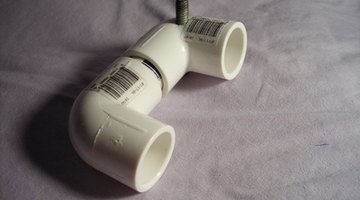Types of PVC Cement
Table of Contents
PVC cement is a chemical solvent. It literally fuses the pieces of pipe together. There are three primary types of plastic piping used, but all are generally referred to as PVC pipe. Each type of PVC requires a different cement.

PVC (Polyvinyl Chloride) and CPVC (Chlorinated Polyvinyl Chloride) are very similar, while ABS (Acrylonitrile Butadiene Styrene) has a different chemical composition.
PVC Cement

PVC cement is specially formulated for schedules 40 and 80 PVC pipe. When it is applied, the pipe will visibly soften and then solidify as the cement sets to form a joint that is stronger than the surrounding pipe and fittings. Be careful to avoid skin contact because PVC cement can cause chemical burns on sensitive skin. This pipe and cement are generally used in DWV (drain, waste and vent) applications, not potable water transport.
CPVC Cement

CPVC cement can bond pipe joints without creating hazardous vapors when fusing PVC pipe designed for potable water transport. Apply the cement with the included dauber, uniformly lining the connecting surfaces. Avoid CPVC cements that have thickened as this is an indication that the catalyzing agents have partially evaporated, reducing its bonding capability.
ABS Cement
ABS cement is chemically engineered to react with the chemical structure of the pipe. It is used with ABS piping, but is unsuitable for use with CPVC or PVC pipes. ABS piping is recommended for DWV applications and is available in two types: Solid Wall and Cellular Core. It is important to use the correct type of cement in all applications to prevent the pipe from weakening and unable to carry the desired pressure.
Transitional Cement
A special type of cement called a transitional cement can be used when multiple types of PVC pipe, such as ABS and PVC, are joined. This variety of cement fuses the chemical structures of the pipes together without causing extreme chemicals reactions or creating harmful fumes.
Colored Cement Labels
In addition to cements made for different types of plastic pipe, there are also formulations designed for certain applications, indicated by the label color. The blue label is used for quick sets. The orange label is designed for for cold weather applications. And an aqua blue label is intended for underwater or damp installation uses.
The Drip Cap
- PVC cement is a chemical solvent.
- PVC cement is specially formulated for schedules 40 and 80 PVC pipe.
- ABS cement is chemically engineered to react with the chemical structure of the pipe.
- A special type of cement called a transitional cement can be used when multiple types of PVC pipe, such as ABS and PVC, are joined.
- This variety of cement fuses the chemical structures of the pipes together without causing extreme chemicals reactions or creating harmful fumes.
References
Resources
Writer Bio
Roger Golden began his career as a writer in 2008, when he began writing weekly insurance and personal finance articles. Golden's work has appeared on eHow, USAToday.com, TheSpoof.com and his privately managed blogs, .modern Dislogic and Outdoors—Dixie Style.
Photo Credits
- PVC image by pearlguy from Fotolia.com
- PVC image by pearlguy from Fotolia.com
- Pipes and more pipes image by rider from Fotolia.com
- framed plumbed and wired image by Scott Patterson from Fotolia.com
More Articles



